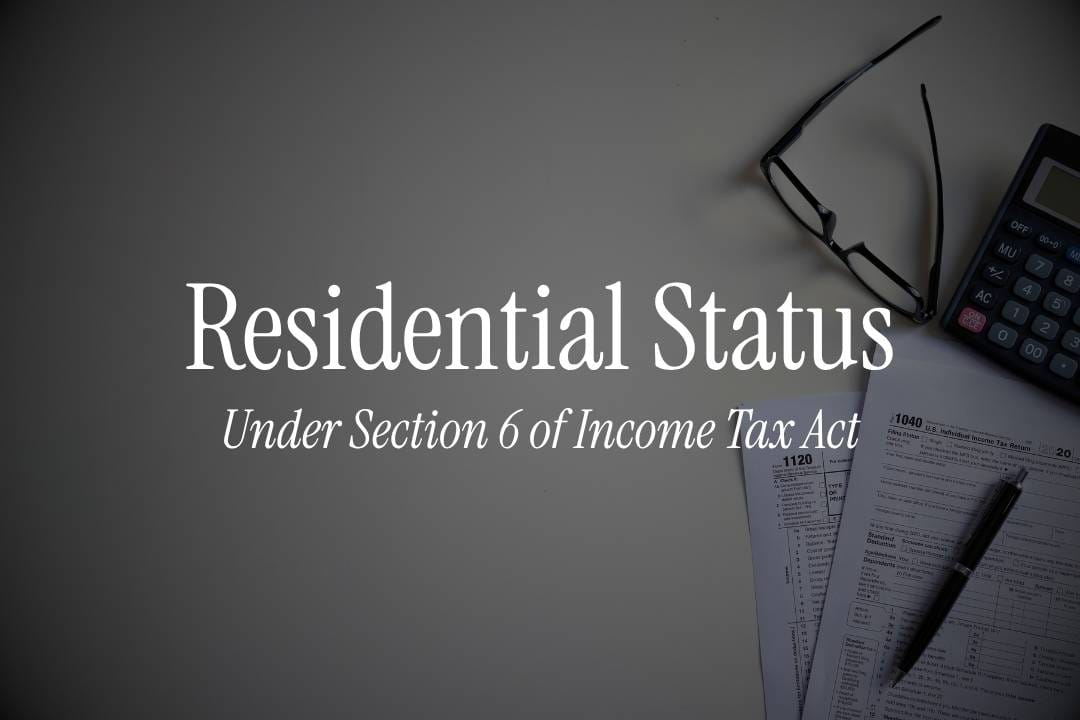
For NRIs, it can be tricky to manage and comply with tax laws and regulations in different countries. Understandably, these regulations can sometimes be unclear and complex. Despite their ambiguity, one of the most crucial tax laws for any NRIs to be aware of is Section 6 of the Income Tax Act. This is because it deals with the residential status of a person for income tax purposes.
We would dive deeper into the residential status according to Section 6 of the Income Tax Act.
What is Residential Status & Why It Matters
Determining the residential status of an individual is crucial because it affects how their income is taxed in India. However, this is not to be confused with individual citizenship. Residential status is strictly restricted to determining an individual's tax liability. For instance, an individual who is a citizen of India may end up being a non-resident for a particular year. Likewise, a foreigner staying in India could end up being a resident of India for a particular year.
Therefore, it becomes necessary to have a system to identify and classify residents and non-residents of India, as well as their respective tax liabilities to the nation. The same logic applies to legal entities (such as corporations) whose residential statuses are determined differently.
Types of Residential Status Under the Income Tax Act
Under the Income Tax Act, there are three types of resident classifications. These classifications are based on the length of time an individual has spent living in India. More importantly, the period of time in which length of stay is considered can include both the current fiscal year as well as previous years of stay.
The three types of classifications are as follows:
Resident and Ordinarily Resident (ROR)
Non-Resident (NR)
Resident but Not Ordinarily Resident (RNOR)
Resident and Ordinarily Resident (ROR)
An individual will be treated as a Resident in India in any previous year if he/she satisfies any of the following conditions:
- If he/she is in India for a period of 182 days or more during the previous year, or
- If he/she is in India for a period of 60 days or more during the previous year and 365 days or more during 4 years immediately preceding the previous year.
An individual who does not satisfy both the conditions as mentioned above will be treated as a Non-Resident in that previous year.
However, in respect of an Indian citizen and a person of Indian origin who visits India during the year, the period of 60 days as mentioned in (2) above shall be substituted with 182 days. A similar concession is provided to the Indian citizen who leaves India in any previous year as a crew member or for the purpose of employment outside India.
The Finance Act, 2020, w.e.f. Assessment Year 2021-22 has amended the above exception to provide that the period of 60 days as mentioned in (2) above shall be substituted with 120 days, if an Indian citizen or a person of Indian origin whose Total Income, other than Income from Foreign Sources, exceeds ₹ 15 lakh during the previous year.
The Finance Act, 2020 has also introduced a new Section 6(1A), which is applicable from Assessment Year 2021-22. It provides that an Indian citizen earning a Total Income in excess of ₹ 15 lakh (other than income from foreign sources) shall be deemed to be a Resident in India if he/she is not liable to pay tax in any country.
(Source: Income Tax Website)
Resident but Not Ordinarily Resident (RNOR)
To qualify for RNOR :
If s/he were a non-resident in nine out of the 10 preceding financial years, OR,
If you’ve spent less than 729 days in India over the past seven years.
Non-Resident (NR)
If the above-mentioned conditions are not met for either Resident (ROR) or Resident but Not Ordinarily Resident (NROR), the individual is considered Non-Resident (NR).
You can check your residential status for taxation purposes using Belong’s Residential Status Calculator tool by answering a few simple questions.
Tax Implications Based on Residential Status
If an individual is considered a resident, s/he is liable to pay taxes on his global income. In this respect, “global income” refers to income earned in and outside India. However, for those considered NR and NROR, taxation only applies to income generated within India.
In some instances where individuals are subject to taxation on income in India and in another country, they can always claim tax relief under the Double Tax Avoidance Agreement (DTAA). DTAAs are agreements signed by countries with each other to help their citizens avoid paying taxes twice on the same income generated across multiple borders. To date, India has signed over 80+ DTAAs with other countries, such as the UAE, USA, etc., to support its NRI population.
Income Tax Slabs & Exemptions for Each Category
For Residents, the latest Income Tax Slab (proposed to come into effect from April 1, 2025) outlines the following tax implications:
Table 1: Tax Slabs Under the Old Tax Regime
Income tax slabs (Rs) | Income Tax Rate (%) |
From 0 to 2,50,000 | 0 |
From 2,50,001 to 5,00,000 | 5 |
From 5,00,001 to 10,00,000 | 20 |
From 10,00,001 and above | 30 |
Table 2: Tax Slabs Under the New Tax Regime
Income tax slabs (Rs) | Income Tax Rate (%) |
From 0 to 4,00,000 | 0 |
From 4,00,001 to 8,00,000 | 5 |
From 8,00,001 to 12,00,000 | 10 |
From 12,00,001 to 16,00,000 | 15 |
From 16,00,001 to 20,00,000 | 20 |
From 20,00,001 to 24,00,001 | 25 |
From 24,00,001 and above | 30 |
| Also Read: UAE Tax Residency Certificate
For Non-Residents (NR) and RNOR, income tax obligations are strictly limited to income generated and received in India. All other foreign income remains non-taxable in India. For income generated in India, the tax slab is the same as for Residents (RORs) [summarised in the above table]. However, if opting for the new tax regime, these individuals are no longer eligible for certain deductions specified under the Income Tax Act under section 80.
Foreign Income Taxation Rules
If the income is earned in India, it is typically subject to taxation. Though it can sometimes be hard to keep track of all the taxation rules surrounding the origin of income generated. To overcome this issue, we must first understand what is considered “foreign income” and what is not, and the different types of resident classifications. The table below accurately summarises these rules:
| Type of Income | ROR (Residents) | RNOR (Residents but Not Ordinarily Resident) | Non-Resident |
|---|---|---|---|
| Income generated or received in India | Taxable | Taxable | Taxable |
| Income outside India (from businesses controlled outside India or a profession established outside India) | Taxable | Non-Taxable | Non-Taxable |
| Income outside India (other sources) | Taxable | Non-Taxable | Non-Taxable |
Practical Examples & Case Studies
Consider Anand, who is an Indian Citizen who works for a multinational company and is deputed to its branch in Singapore. During the financial year, he spends 200 days in Singapore and 165 days in India and earns ₹20 Lakhs from Indian Sources and ₹38 Lakhs from Singaporean sources. What residency status does he qualify for?
Well, to qualify as a resident of India for tax purposes, an individual must either observe the 182-day or 60-day rule. As he was away in Singapore for employment purposes, the 60-day rule will be substituted with the 182-day rule. However, since he had only stayed in India for 165 days, his case failed both conditions. Consequently, Anand only qualifies as a Non-Resident for the financial year. Therefore, he is liable to pay taxes for the ₹20 Lakhs sourced from India, but is not liable to pay taxes on the ₹38 lakhs sourced from Singapore.
Tax Planning Strategies Based on Residential Status
Since effective tax planning hinges significantly on an individual’s residential status, understanding and strategically managing this status is absolutely crucial to having optimised tax liabilities. Below are some examples that Individuals can utilise to effectively minimise their tax liabilities using key tax regulations to their benefit:
Understanding your Residential Status: This is the first and most important step in identifying strategies to optimise tax liabilities. Your residential status is key to unlocking several tax benefits awarded to individuals of different residency types, such as ROR, RNOR and NR.
You can check out our residential status calculator to identify your residential status. Residential Status Calculator | Check Your NRI Status Instantly
Leveraging DTAA provisions: By leveraging DTAA agreements, NRIs can claim tax credits or exemptions on income taxed in India and their country of residence.
Investing in Tax-Efficient Instruments: NRs, NREs, and FCNR accounts offer tax-free interest rates. In addition to this, they can invest in certain
How NRIs Can Reduce Tax Liability?
NRIs can utilise the exemptions and deductions provided in the Income Tax Act to reduce their tax liabilities in India. These deductions & exemptions include the following:
- Property transactions: Capital gain exemptions for the sale of properties are contingent on conditions specified under Section 54 of the Income Tax Act..
- Bank accounts and bonds: Tax exemptions available on the interest earned on an NRE or FCNR account, interest earned on notified bonds and savings certificates issued by the government
- Life insurance premium: Deductions available on NRI life insurance premiums up to ₹1.5 lakhs paid to self and/or family (only available under the Old Tax Regime)
- Education loans: Deductions available on tuition fees paid to an educational institute for full-time education (limited to two children under the old tax regime)
- Using DTAA: Avoidance of Double Taxation on income generated across multiple borders under DTAA (Double Taxation Avoidance Agreements).

DTAA (Double Taxation Avoidance Agreement) Benefits
The key benefits of DTAA (especially for NRIs) include avoidance of double taxation, tax credit, exemption, and reduced rates of taxes (special rates). The individual concerned has to get the tax residency certificate (TRC) from the country of residence. After this, they have to fill out the Form-10F while filing their IT returns.
Misconceptions About Residential Status
As there are many conditions and caveats for meeting the different types of residency statuses under the Income Tax Act, there are also considerable chances for misconceptions to arise for various individuals.
Interestingly, due to these common misconceptions, individuals often overlook the benefits awarded to different residency types under the new tax regime. Let’s look at some common misconceptions and their ground realities.
Misconception 1 - Equating Residential Status with Citizenship: Many believe that just because they are Indian citizens, they automatically qualify for residential status for tax purposes. But this is simply not true. To be considered a Resident, an individual must meet either the 182 or 60-day rule.
Misconception 2 - Assuming Global Income is Always Taxed in India: This is a fairly popular misconception that people seem to hold regardless of their residential status. But in reality, only residents are taxed on their global income. For RNORs and NRs, the criteria for taxation strictly apply to income accrued or otherwise received in India.
Misconception 3 - Assuming Residential Status is Permanent: People tend to believe that if they have been awarded a resident or non-resident status, this status remains unchanged. Residential statuses are determined annually based on the conditions specified. It is liable to change year-on-year.
In conclusion, understanding the concept of residential status under the Income Tax Act is important as it determines one’s tax obligations. Individuals can be classified into three different resident types: ROR (Resident & Ordinarily Resident), RNOR (Resident but not Ordinarily Resident), and NR (Non-Resident). These classifications help determine the scope of taxation and the strategies individuals can utilise to optimise their tax liabilities.
Misconception 3 - Assuming Residential Status is Permanent: People tend to believe that if they have been awarded a resident or non-resident status, this status remains unchanged. Residential statuses are determined annually based on the conditions specified. It is liable to change year-on-year.
As there are many conditions and caveats for meeting the different types of residency statuses under the Income Tax Act, there are also considerable chances for misconceptions to arise for various individuals. Interestingly, due to these common misconceptions, individuals often overlook the benefits awarded to different residency types under the new tax regime. Let’s look at some common misconceptions and their ground realities.
Misconception 1 - Equating Residential Status with Citizenship: Many believe that just because they are Indian citizens, they automatically qualify for residential status for tax purposes. But this is simply not true. To be considered a Resident, an individual must meet either the 182 or 60-day rule.
Misconception 2 - Assuming Global Income is Always Taxed In India: This is a fairly popular misconception that people seem to hold regardless of their residential status. But in reality, only residents are taxed on their global income. For RNORs and NRs, the criteria for taxation strictly apply to income accrued or otherwise received in India.
Misconception 3 - Assuming Residential Status is Permanent: People tend to believe that if they have been awarded a resident or non-resident status, this status remains unchanged. However, this is patently false. Instead, residency statuses are determined annually based on the conditions specified and, thus, are liable to change year-on-year.
Failure to Report Foreign Income
If failing to report foreign income under the Income Tax Act, particularly within the framework of the new tax regime, an individual is subject to significant penalties and legal consequences. These regulations fall under the Black Money (Undisclosed Foreign Income and Assets) and Imposition of Tax Act, 2015.
The Non-Disclosure of foreign income can attract the following consequences:
Penalty Imposition: Given under section 43 of the Black Money Act, failure to disclose foreign income or assets in the income tax return can result in a penalty of ₹10 Lakhs if the aggregate value of such income or assets (excluding immovable property) exceeds ₹20 Lakhs.
Assessment Proceedings & Prosecution: In addition to monetary penalties, assessment proceedings can be triggered (which would involve a thorough investigation of the taxpayer's financial affairs), and prosecution proceedings may also be initiated (which can result in imprisonment and further fines).
You may also like to know more about
Conclusion
In conclusion, understanding the concept of residential status under the Income Tax Act is important as it determines one’s tax obligations. Individuals can be classified into three different resident types: ROR (Resident & Ordinarily Resident), RNOR (Resident but not Ordinarily Resident), and NR (Non-Resident). These classifications help determine the scope of taxation and the strategies individuals can utilise to optimise their tax liabilities.
Because tax regulations are complex and ever-evolving, they give rise to many misconceptions. Staying up-to-date on policy changes (such as regulations under the new tax regime) is essential, no matter your residential status.




